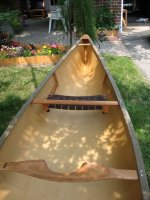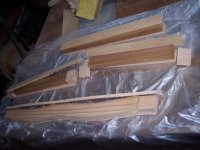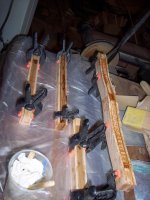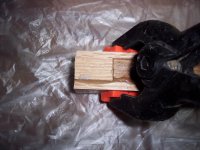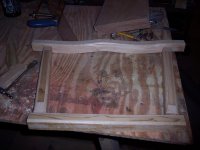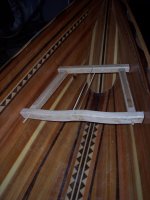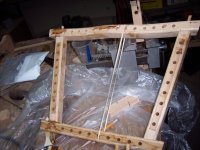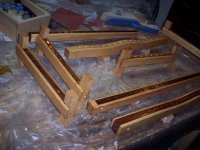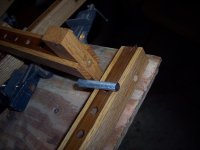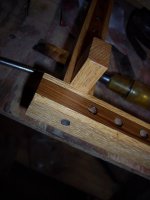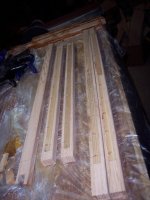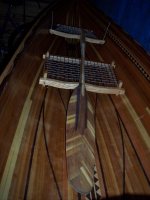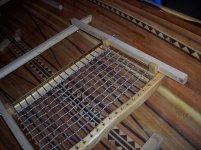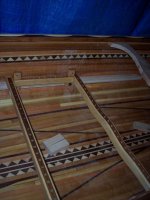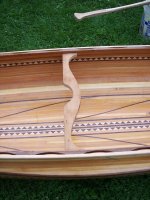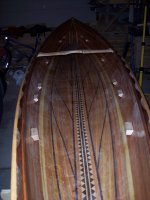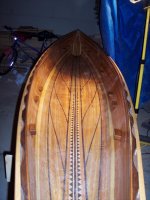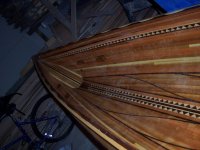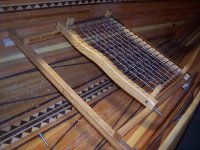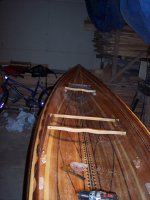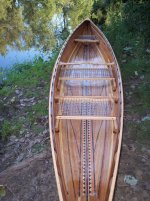Cruiser How many batches of epoxy does that work out to? I've noticed that the mix I'm currently using is wicking into the wood, especially the cedar. I've been painting a thin coat, and then coming back and adding more just before closing the joints. I'm also having the "Luxury" of a fully warmed up shop over the summer, which means I'm having reallyfastepoxykickover!
stripperguy I'm having what seem to be tracking issues, but don't seem to make intuitive sense....
First, a word about my stance: In the center position, I'm working seated, with a sort of modified Canadian setup. Hull heeled to the side, with me tucked up under the gunwale. I've done some short stints kneeling, but have not found it comfortable, So I'm seated, 5-6 inches off the bottom. With no load, I've got my Stomach just a couple of inches aft of center. Either both legs stretched out front, or one curled up, half Indian style.
The hull seems fast enough for day to day use. I can tell that at the top end, two paddlers going all out, Its somewhat slower than my last build, but I don't anticipate doing much at that edge of performance anyway. Steady, Gentle distance paddling seems about the same.
If, by "Lively," you mean "Tippy," not so much. Sitting high near the ends is not a good idea, but I can kneel just about anywhere along the length. I can also stand near the center with no load, and if I had a SUP paddle, would be able to handle the canoe with similar success to an actual SUP board. (Though, I did end in the lake the only time I tried one! Got cocky near the end)
She seems to turn easily enough, but this is where things start to get odd: I've got a fair git of rocker, and with the canoe heeled, I'd expect both stems to be free of the water. (I have not been able to get an observer to confirm that) However, when a significant turn happens, often one end (Usually the bow) sort of "plants" and the canoe pivots around it. I get a lot of flow noise from the other end in these circumstances, sounds spread out, like a cresting ripple 3-4 feet long being pushed along by the hull.
Tracking is my big bugaboo, though. A straight back stroke, of course, tends to spin the canoe around its axis. I try to add some correction at the end of the stroke, what some people call a 'goon' stroke. To get an effect, I have to apply a lot of pressure, and tend to loose a lot of my forward thrust in the bargain. I've also experimented with adding some correction to the beginning of the stroke. If you've ever seen Rolf Kraiker's demo on youtube, think of the forward portion of his version of the box stroke, just without the in-water return. (My current paddles aren't faired well enough to do that) The problem is, this seems also to make me turn away from the paddle side. If I consistently apply the end-of-stroke correction, I'll eventually start to turn toward the paddle side.
When paddling from the stern position, with a load out front for balance, I have significantly reduced issues with this, though it still happens when I'm at approx. 1/3 hull length. Have not put together a solo load that is heavy enough to experiment with my full back stern position.

